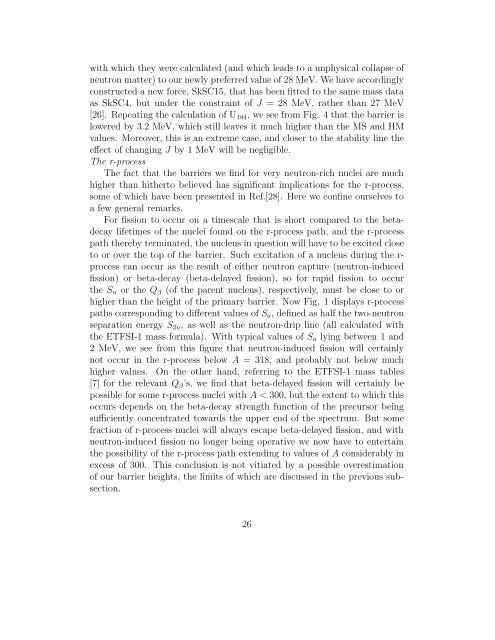Fission Barriers of Neutron-rich and Superheavy Nuclei calculated ...
Fission Barriers of Neutron-rich and Superheavy Nuclei calculated ...
Fission Barriers of Neutron-rich and Superheavy Nuclei calculated ...
You also want an ePaper? Increase the reach of your titles
YUMPU automatically turns print PDFs into web optimized ePapers that Google loves.
with which they were <strong>calculated</strong> (<strong>and</strong> which leads to a unphysical collapse <strong>of</strong><br />
neutron matter) to our newly preferred value <strong>of</strong> 28 MeV. We have accordingly<br />
constructed a new force, SkSC15, that has been fitted to the same mass data<br />
as SkSC4, but under the constraint <strong>of</strong> J = 28 MeV, rather than 27 MeV<br />
[26]. Repeating the calculation <strong>of</strong> U184, we see from Fig. 4 that the barrier is<br />
lowered by 3.2 MeV, which still leaves it much higher than the MS <strong>and</strong> HM<br />
values. Moreover, this is an extreme case, <strong>and</strong> closer to the stability line the<br />
effect <strong>of</strong> changing J by 1 MeV will be negligible.<br />
The r-process<br />
The fact that the barriers we find for very neutron-<strong>rich</strong> nuclei are much<br />
higher than hitherto believed has significant implications for the r-process,<br />
some <strong>of</strong> which have been presented in Ref.[28]. Here we confine ourselves to<br />
a few general remarks.<br />
For fission to occur on a timescale that is short compared to the betadecay<br />
lifetimes <strong>of</strong> the nuclei found on the r-process path, <strong>and</strong> the r-process<br />
path thereby terminated, the nucleus in question will have to be excited close<br />
to or over the top <strong>of</strong> the barrier. Such excitation <strong>of</strong> a nucleus during the rprocess<br />
can occur as the result <strong>of</strong> either neutron capture (neutron-induced<br />
fission) or beta-decay (beta-delayed fission), so for rapid fission to occur<br />
the Sn or the Qβ (<strong>of</strong> the parent nucleus), respectively, must be close to or<br />
higher than the height <strong>of</strong> the primary barrier. Now Fig. 1 displays r-process<br />
paths corresponding to different values <strong>of</strong> Sa, defined as half the two-neutron<br />
separation energy S2n, as well as the neutron-drip line (all <strong>calculated</strong> with<br />
the ETFSI-1 mass formula). With typical values <strong>of</strong> Sa lying between 1 <strong>and</strong><br />
2 MeV, we see from this figure that neutron-induced fission will certainly<br />
not occur in the r-process below A = 318, <strong>and</strong> probably not below much<br />
higher values. On the other h<strong>and</strong>, referring to the ETFSI-1 mass tables<br />
[7] for the relevant Qβ’s, we find that beta-delayed fission will certainly be<br />
possible for some r-process nuclei with A















